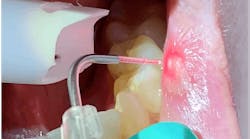American Academy of Periodontology issues report on peri-implant disease risk factors, diagnoses, and clinical implications
Chicago, IL – (April 1, 2013) The American Academy of Periodontology (AAP) recently published a report, “Peri-Implant Mucositis and Peri-Implantitis: A Current Understanding of Their Diagnoses and Clinical Implications” in April’s Journal of Periodontology. The paper was developed in an effort to review the current knowledge of peri-implant mucositis and peri-implantitis, and guide dental professionals in their diagnoses and disease prevention.
Read the PDF here.
Both peri-implant mucositis and peri-implantitis are characterized by an inflammatory reaction in the tissues surrounding a dental implant that can lead to tissue destruction and, ultimately, implant failure. Peri-implant mucositis is confined to the soft tissue with no sign of supporting bone loss. Peri-implantitis, similar to periodontitis, results in inflammation around the soft tissue as well as progressive bone loss. Additionally, peri-implant mucositis may be successfully treated using nonsurgical efforts if detected early, whereas peri-implantitis usually requires surgical treatment.
RELATED |I'll have a maxillary anterior implant to go; please hold the periodontal treatment
According to Paul Rosen, DMD, MS, chair of the AAP Task Force on Peri-Implantitis, “Although there are widespread clinical reports where dental implants have achieved long-term success, it is important for dental professionals to understand that peri-implant mucositis or peri-implantitis may arise from a failure to identify risk factors, improper treatment planning, suboptimal surgical or prosthetic execution, and/or improper maintenance care. We can’t ignore the reality that patients could be suffering from peri-implant mucositis or peri-implantitis and should continually work towards understanding the disease, treatment, and contributing risk factors.”
RELATED |Pearls For Your Practice: A must-have tool to combat periodontitis and peri-implantitis
The report outlines numerous key components to aid clinicians in understanding the disease, including disease background, diagnoses, prevalence and incidence, etiologies and pathogenesis, risk factors (including previous periodontal disease, poor plaque control, residual cement, smoking, genetic factors, diabetes, and occlusal overload) and suggested routine following diagnosis.
In the report, it’s recommended that with any implant patient, dental professionals identify possible peri-implant disease risk factors, establish a radiographic baseline at the time of implant placement and continually monitor the implant’s health, intervening early if inflammatory complications arise. Nancy Newhouse, DDS, MS, president of the American Academy of Periodontology and an assistant clinical professor at the University of Missouri – Kansas City School of Dentistry adds, “Because evidence suggests that early diagnosis and treatment leads to optimal treatment outcomes, regular monitoring of dental implants as part of a comprehensive periodontal evaluation and proper maintenance is crucial to a patient’s implant health.”
Recent reports (1,2) revealed that peri-implant mucositis was present in 48% of implants followed from nine to 14 years after placement. (2) However, because peri-implant mucositis is reversible with early intervention, (3,4) it is quite possible that its prevalence could be under-reported. Research concerning peri-implantitis reported distinct differences in the incidence and prevalence from numerous authors with studies ranging from 6.61% disease prevalence over a nine- to 14-year period (2) to 36.6% with a mean of 8.4 years after loading. (5)
The statement, developed by an expert committee appointed by the AAP and reviewed and approved by the AAP Board of Trustees, is available for public access here.
The periodontal community remains committed as leaders in the placement, maintenance, and treatment of dental implants — both healthy and those presenting with disease. As a result, the AAP recognizes that new studies will continue to emerge, and as such, the report represents an ongoing endeavor that will evolve and require further expansion and reevaluation.
Study information
1. Fransson C, Lekholm U, Jemt T, Berglundh T. Prevalence of subjects with progressive bone loss at implants. Clin Oral Implants Res 2005;16:440-446.
2. Roos-Jansåker AM, Lindahl C, Renvert H, Renvert S. Nine- to fourteen-year follow-up of implant treatment. Part II: Presence of peri-implant lesions. J Clin Periodontol 2006;33:290-295.
3. Pontoriero R, Tonetti MP, Carnevale G, Mombelli A, Nyman SR, Lang NP. Experimentally induced periimplantmucositis. A clinical study in humans. Clin OralImplants Res 1994;5:254259.
4. Salvi GE, Aglietta M, Eick S, Sculean A, Lang NP, Ramseier CA. Reversibility of experimental peri-implant mucositis compared with experimental gingivitis in humans. Clin Oral Implants Res 2012;23:182-190.
5. Koldsland OC, Scheie A, Aass AM. Prevalence of peri-implantitis related to severity of the disease with different degrees of bone loss. J Periodontol 2010;81:231-238.





